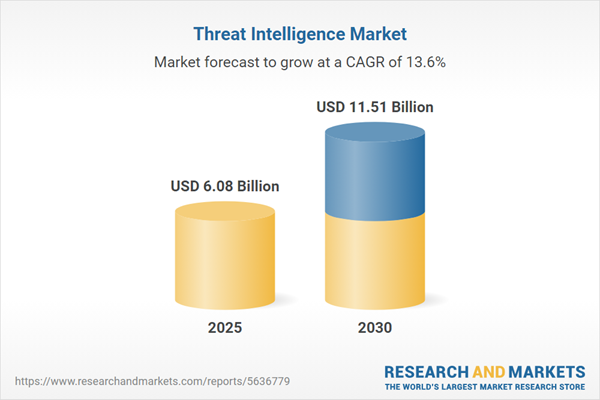Threat intelligence involves collecting, processing, and analyzing data to understand attackers' motives, goals, and attack patterns. Its primary aim is to empower organizations to make data-driven security decisions, transitioning from reactive to proactive strategies against cyber threats. The growing reliance on digitalization and cloud-based platforms has heightened cyber risks, driving demand for threat intelligence solutions and expanding the market.
Market Drivers
Surge in Cyber-Attacks and Fraud
The escalating frequency and sophistication of cyber-attacks are key drivers of the threat intelligence market. In 2022, notable incidents underscored this trend. For instance, in April 2022, Romanian government, military, banking, and media websites faced multiple DDoS attacks, disrupting operations. That same month, MailChimp experienced a social engineering attack, compromising data of approximately 100 clients by accessing internal customer support and account administration tools. In May 2022, a data breach at Ikea Canada affected around 95,000 customers. Additionally, in February 2022, cyberattacks crippled oil terminals in German and Belgian ports, halting barge processing. Cisco’s Annual Internet Report projected 15.4 million DDoS attacks by 2023, reflecting the growing threat landscape. These incidents highlight the urgent need for robust threat intelligence to mitigate risks and protect critical systems.Strategic Initiatives by Key Players
The market is propelled by proactive strategies from industry leaders, including product launches, acquisitions, and training programs. In 2025, the focus remains on addressing rising cybersecurity concerns as enterprises seek advanced solutions to prevent breaches. Key developments include:New Product Launches: Companies are introducing innovative threat intelligence platforms to meet market demand. While specific 2025 launches are not detailed, the trend of deploying advanced platforms persists, building on 2021 examples like Logically’s partnership with Raxa Security Services to launch Logically Intelligence (LI), a cloud-based platform offering at-scale threat analysis and countermeasures.
Strategic Acquisitions: Acquisitions continue to strengthen market offerings. For example, Rapid7, Inc.’s 2021 acquisition of IntSights Cyber Intelligence Ltd. combined external threat intelligence with community-driven insights, enabling comprehensive threat monitoring and mitigation for enterprises. Such moves enhance global presence and service capabilities, a trend likely continuing into 2025 as firms aim to unify internal and external threat intelligence.
Cybersecurity Training Programs: Addressing the skills gap is critical, as evidenced by Fortinet’s April 2022 initiative to launch cybersecurity awareness training aligned with NIST standards. The program covered data privacy, information security, physical security, internet security, and password protection, responding to a survey indicating 73% of organizations experienced breaches due to inadequate cybersecurity skills. Similar initiatives in 2025 are expected to further bolster workforce preparedness, driving market growth by enhancing organizational resilience.
Market Outlook
The threat intelligence market is poised for continued expansion in 2025, driven by the persistent rise in cyber threats and the need for proactive security measures. Advancements in digitalization, while transformative, amplify vulnerabilities, necessitating robust threat intelligence solutions. Key players are likely to sustain momentum through innovative platforms, strategic acquisitions, and training programs to address evolving threats. The focus on integrating external and internal intelligence, as seen in prior acquisitions, and enhancing workforce skills will remain critical. As cyber-attacks grow in scale and impact, organizations across sectors will increasingly rely on threat intelligence to safeguard data, infrastructure, and operations, making it a cornerstone of modern cybersecurity strategies.Key Benefits of this Report:
- Insightful Analysis: Gain detailed market insights covering major as well as emerging geographical regions, focusing on customer segments, government policies and socio-economic factors, consumer preferences, industry verticals, and other sub-segments.
- Competitive Landscape: Understand the strategic maneuvers employed by key players globally to understand possible market penetration with the correct strategy.
- Market Drivers & Future Trends: Explore the dynamic factors and pivotal market trends and how they will shape future market developments.
- Actionable Recommendations: Utilize the insights to exercise strategic decisions to uncover new business streams and revenues in a dynamic environment.
- Caters to a Wide Audience: Beneficial and cost-effective for startups, research institutions, consultants, SMEs, and large enterprises.
What do businesses use our reports for?
Industry and Market Insights, Opportunity Assessment, Product Demand Forecasting, Market Entry Strategy, Geographical Expansion, Capital Investment Decisions, Regulatory Framework & Implications, New Product Development, Competitive IntelligenceReport Coverage:
- Historical data from 2022 to 2024 & forecast data from 2025 to 2030
- Growth Opportunities, Challenges, Supply Chain Outlook, Regulatory Framework, and Trend Analysis
- Competitive Positioning, Strategies, and Market Share Analysis
- Revenue Growth and Forecast Assessment of segments and regions including countries
- Company Profiling (Strategies, Products, Financial Information, and Key Developments among others).
Market Segments
By Solution Type
- Threat Intelligence Platforms
- Security Information and Event Management (SIEM)
- Log Management
- Security and Vulnerability Management
- Identity and Access Management (IAM)
- Risk Management
- Incident Forensics
By Offering
- Solutions
- Services
By Deployment
- On-Premise
- Cloud
By End-User Industry
- BFSI
- Government
- Retail
- IT and Telecom
- Healthcare
- Others
By Geography
- North America
- USA
- Canada
- Mexico
- South America
- Brazil
- Argentina
- Others
- Europe
- Germany
- France
- UK
- Spain
- Others
- Middle East and Africa
- Israel
- Saudi Arabia
- Others
- Asia Pacific
- China
- Japan
- South Korea
- India
- Others
Table of Contents
Companies Mentioned
- Fortinet, Inc.
- Recorded Future, Inc.
- CrowdStrike Holdings, Inc.
- IBM Corporation
- Cisco Systems, Inc.
- Palo Alto Networks, Inc.
- Broadcom, Inc. (Symantec Corporation)
- FireEye, Inc. (Mandiant Advantage)
- Trend Micro Incorporated
- Dell Technologies Inc.
- Siemens AG
Table Information
| Report Attribute | Details |
|---|---|
| No. of Pages | 145 |
| Published | June 2025 |
| Forecast Period | 2025 - 2030 |
| Estimated Market Value ( USD | $ 6.08 Billion |
| Forecasted Market Value ( USD | $ 11.51 Billion |
| Compound Annual Growth Rate | 13.6% |
| Regions Covered | Global |
| No. of Companies Mentioned | 11 |









